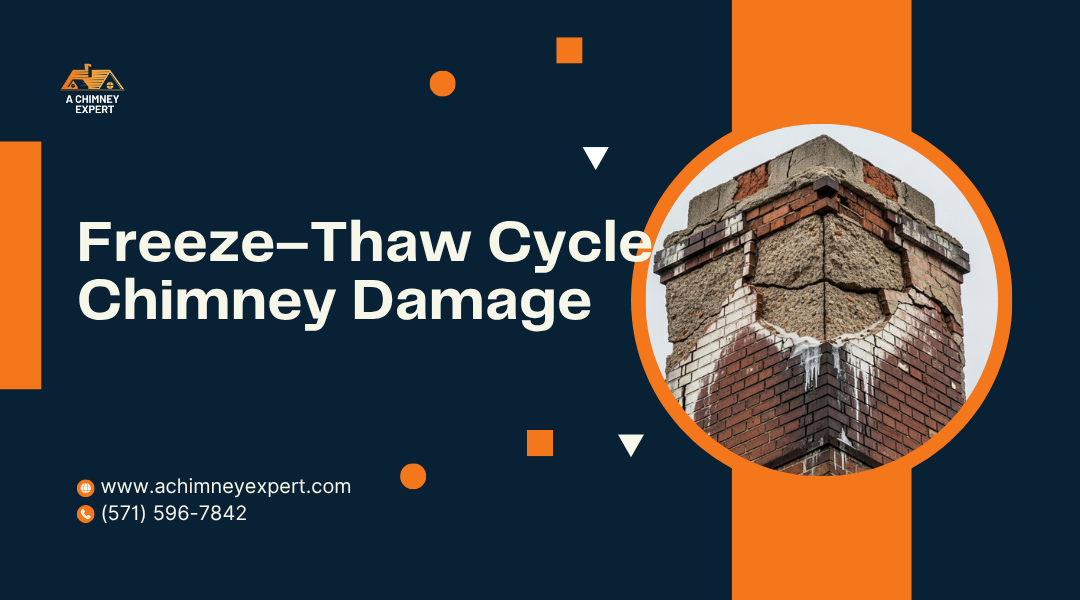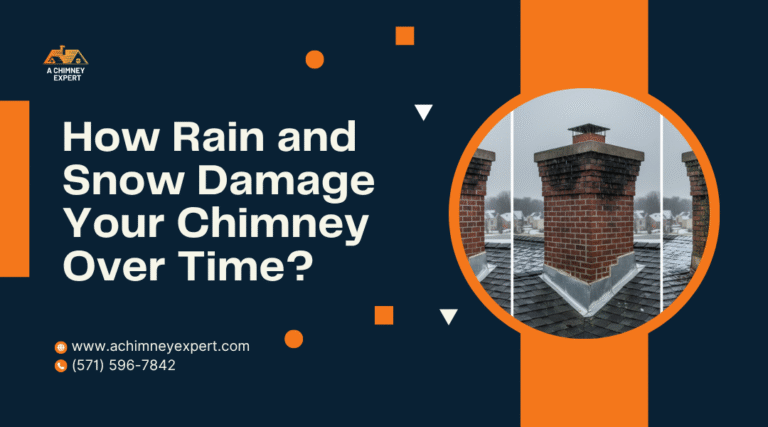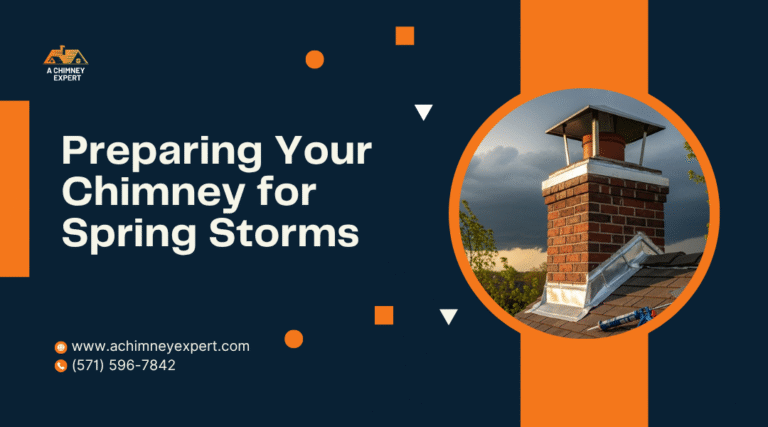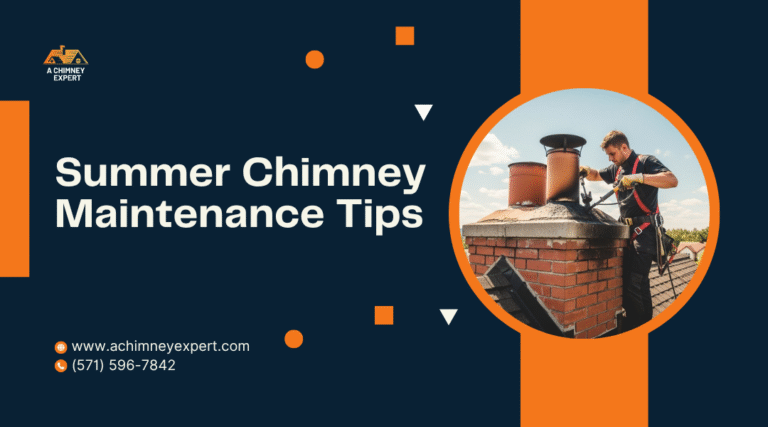When winter temperatures swing between freezing and thawing, your chimney faces a silent but serious threat. Moisture seeps into tiny cracks in the brick and mortar, freezes, expands, and forces those cracks wider. During a freeze–thaw cycle, this repeated expansion and contraction weakens your chimney’s structure and can lead to costly damage if left unchecked.
You might notice small chips, crumbling mortar, or even leaks near your fireplace, but these are often signs of deeper problems caused by the freeze–thaw process. Each cycle adds stress to your chimney’s masonry, slowly breaking down its strength and stability. Over time, this can lead to structural issues that threaten both safety and efficiency.
At A Chimney Expert LLC in Oak Grove, Virginia, you can count on skilled professionals who understand how local weather affects your chimney. By learning what happens during a freeze–thaw cycle and how to prevent damage, you can protect your home and avoid expensive repairs later.
Knowing The Freeze–Thaw Cycle And Its Impact On Chimneys
Cold weather can cause serious wear on brick chimneys. When moisture seeps into masonry and freezes, it expands and weakens the structure. Over time, this process can lead to cracks, loose mortar, and water leaks that threaten both safety and efficiency.
What Is The Freeze–Thaw Cycle?
The freeze–thaw cycle happens when water enters small openings in your chimney’s bricks or mortar and then freezes as temperatures drop. Ice expands by about 9%, pushing against the surrounding material.
When temperatures rise, the ice melts and leaves behind slightly larger gaps. With each cycle, more moisture enters these spaces. This repeated freezing and thawing slowly breaks down the masonry’s strength.
You may notice early signs such as small cracks, flaking surfaces, or crumbling mortar. These are often the first warnings that the freeze–thaw process has started to damage your chimney. Regular inspections after winter help catch these issues before they become major repairs.
How Temperature Fluctuations Affect Masonry Materials
Brick and mortar are porous materials that naturally absorb water. When temperatures swing between freezing and thawing, the trapped moisture expands and contracts. This constant movement stresses the structure and causes deterioration.
The table below shows how temperature changes can affect masonry:
| Temperature Condition | Effect on Masonry |
|---|---|
| Below 32°F (Freezing) | Water turns to ice and expands inside pores |
| Above 32°F (Thawing) | Ice melts, leaving larger cracks for new moisture |
Repeated cycles can loosen mortar joints, cause spalling (when the surface of bricks flakes off), and reduce the chimney’s stability. Even well-built chimneys can suffer damage if exposed to frequent freeze–thaw events without proper maintenance.
Why Chimneys Are Especially Vulnerable To Repeated Freezing And Thawing
Chimneys face more exposure to rain, snow, and cold air than most parts of your home. Their height and location make them a direct target for moisture and temperature changes.
Cracks, worn mortar, or missing caps allow water to enter easily. Once inside, freezing moisture can cause bricks to chip or separate. This damage often spreads from the top down, where exposure is greatest.
Because chimneys must safely vent smoke and gases, structural damage from freeze–thaw cycles can also affect performance. Reduced draft, leaks, and weakened flue liners increase the risk of fire or carbon monoxide exposure. Regular inspections and waterproofing help limit these risks and extend your chimney’s life.
How Moisture Enters And Weakens Your Chimney
Moisture can enter your chimney through small openings and remain trapped inside materials that naturally absorb water. Over time, this weakens the structure, causes cracks, and leads to costly repairs if not addressed early.
Common Entry Points For Water (Cracks, Mortar Joints, Flashing, And Caps)
Water often enters through cracks in the masonry, deteriorated mortar joints, damaged flashing, or missing chimney caps. Each of these areas allows rain, snow, or condensation to seep into the chimney system.
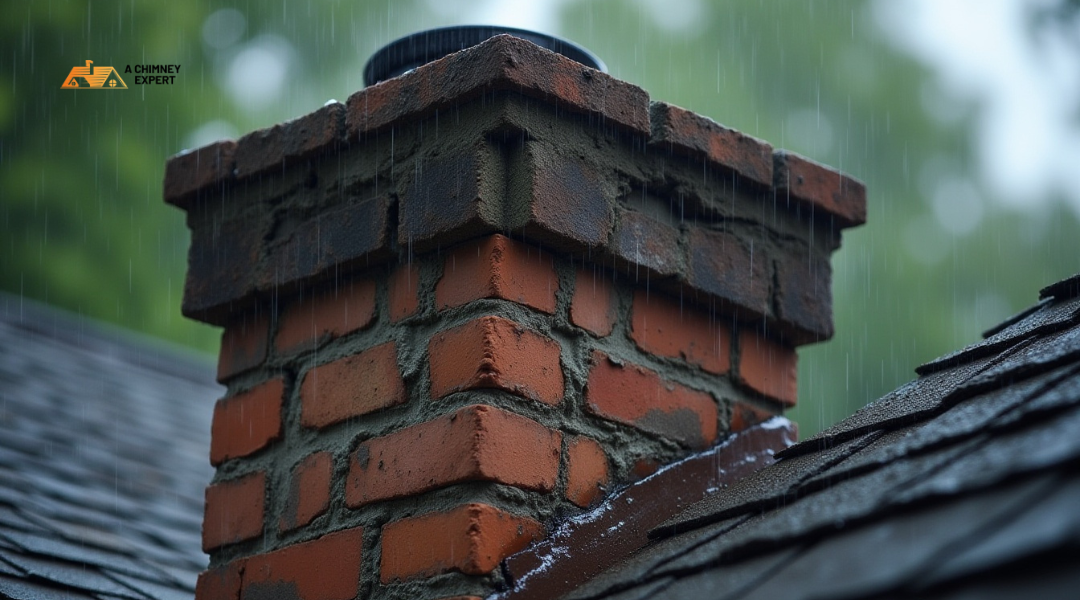
Cracks form as bricks expand and contract with temperature changes. Mortar joints wear down from age and weather, creating gaps where water can collect.
Flashing, the metal seal between the chimney and roof, can loosen or rust. This lets water leak into the attic or walls. A missing or poorly fitted chimney cap leaves the flue open to direct rainfall, debris, and nesting animals.
Regular inspection and repair of these components help prevent moisture from entering and damaging the structure.
| Entry Point | Typical Problem | Result |
|---|---|---|
| Cracks | Expansion/contraction damage | Water infiltration |
| Mortar joints | Erosion or gaps | Structural weakening |
| Flashing | Rust or separation | Roof leaks |
| Chimney cap | Missing or broken | Direct water entry |
How Porous Brick And Mortar Trap Moisture Inside
Bricks and mortar are porous materials, meaning they naturally absorb water like a sponge. When moisture seeps in, it becomes trapped within tiny pores and cracks.
During freezing weather, this trapped water expands as it turns to ice. The pressure causes the surface of the brick to flake or “spall,” leaving it rough and weakened. Repeated freeze-thaw cycles make the damage worse each season.
Even in warmer months, trapped moisture promotes efflorescence, a white powdery deposit that signals internal water movement. Over time, this process erodes the masonry’s strength and reduces its ability to protect your home from heat and smoke.
Applying a breathable waterproofing sealant helps repel water while allowing trapped moisture to escape.
The Hidden Dangers Of Delayed Maintenance
Ignoring small signs of moisture damage can lead to serious structural and indoor problems. Crumbling mortar, peeling paint near the fireplace, or musty smells often indicate hidden leaks.
Unchecked moisture can cause mold growth, stained ceilings, and weakened interior walls. The longer water remains inside the chimney, the more it deteriorates the materials and increases repair costs.
You can prevent these issues by scheduling annual inspections with a certified chimney professional. Timely repairs, proper waterproofing, and a secure chimney cap protect your chimney from long-term water damage.
Staying proactive keeps your chimney safe, efficient, and durable through every season.
The Step-By-Step Damage Process During A Freeze–Thaw Cycle
Cold weather affects your chimney in measurable ways. Moisture seeps into small openings, freezes, expands, and slowly weakens the brick and mortar. This repeated stress changes the structure of your chimney and can lead to costly repairs if not addressed early.
Phase 1: Water Penetration Before The Freeze
Moisture enters your chimney through cracks, porous bricks, or deteriorated mortar joints. Rain, snow, and melting ice can all soak into the masonry surface. Even a small amount of trapped water sets the stage for damage once temperatures drop.
Older chimneys or those without a proper waterproof seal absorb more water. The crown, flashing, and mortar joints are common entry points. When these areas are not properly sealed, water collects inside the brick pores.
Key signs of water penetration include:
- Dark or damp spots on the chimney exterior
- Efflorescence (white salt deposits)
- Crumbling mortar or flaking brick surfaces
Preventing this phase starts with keeping your chimney dry. Regular inspections and waterproofing treatments reduce how much water the masonry absorbs.
Phase 2: Expansion As Water Freezes And Exerts Pressure
When the temperature falls below freezing, the water inside the bricks turns to ice. Ice expands about 9% in volume compared to liquid water. This expansion pushes against the surrounding brick and mortar, creating internal pressure.
Even a small amount of trapped moisture can cause stress cracks. The pressure works outward, breaking the bond between the mortar and the brick. Over time, the surface begins to flake or “spall.”
This phase often goes unnoticed because the damage happens inside the masonry. By the time you see chipped bricks or missing mortar, the internal structure may already be weakened.
Phase 3: Thawing And Structural Weakening Over Time
When temperatures rise, the ice melts and the water seeps deeper into the cracks it helped create. This movement allows moisture to reach new areas of the chimney. Each thawing period leaves the structure slightly weaker than before.
As the masonry softens, mortar joints loosen and bricks shift. Gaps may form between sections, allowing even more water to enter. The repeated wetting and drying also erodes the surface, reducing the chimney’s strength.
If left unchecked, this process can lead to leaning, loose bricks, or partial collapse. Routine maintenance, such as tuckpointing, can help restore stability and prevent further breakdown.
The Cycle Repeats — And Why Small Cracks Become Big Problems
Freeze-thaw cycles rarely happen just once. In climates like Virginia, temperatures often rise and fall around the freezing point many times each winter. Each cycle repeats the same pattern of freezing, expanding, and thawing.
What begins as a hairline crack can grow into a large fracture after dozens of cycles. As the openings widen, more water enters, accelerating the process. This is why early detection and timely repair are essential.
You can slow or stop the cycle by sealing vulnerable areas, repairing mortar joints, and keeping moisture out. Regular inspections from A Chimney Expert LLC ensure small problems don’t grow into major structural issues.
Visible Signs Of Freeze–Thaw Damage On Your Chimney
Repeated freezing and thawing can cause visible damage that worsens with each winter. You may notice crumbling bricks, white stains, or shifting masonry that signal water has entered and expanded inside the chimney’s structure. Interior leaks or unusual drafts can also point to moisture problems caused by freeze–thaw stress.
Spalling Or Flaking Brick Surfaces
When water seeps into the porous surface of your chimney’s bricks, it expands as it freezes. This pressure causes the outer layer of the brick to chip, flake, or break off—a process called spalling.
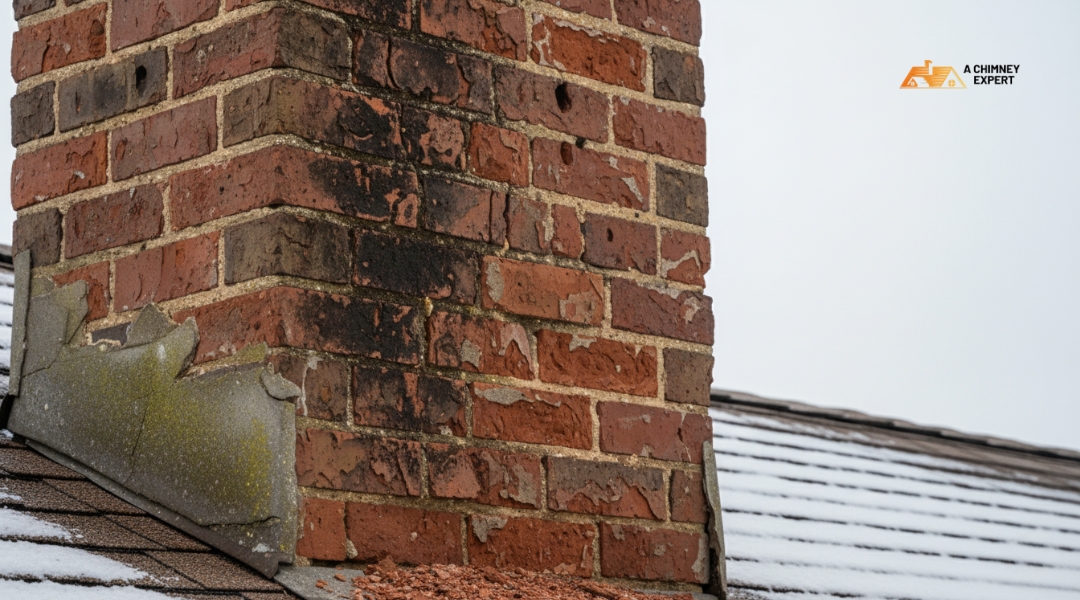
You might see small brick fragments around the base of your chimney or notice rough, uneven patches on the exterior. Over time, spalling exposes the inner brick layers to more moisture, speeding up deterioration.
If left untreated, the damaged bricks can loosen and allow water deeper into the chimney. This can weaken the entire structure and make repairs more costly. Applying a breathable waterproofing treatment and replacing damaged bricks early helps prevent further damage.
White Staining (Efflorescence) And Moisture Marks
White, powdery stains on your chimney’s surface are known as efflorescence. These marks appear when water inside the brick or mortar dissolves natural salts, which then rise to the surface as the moisture evaporates.
Efflorescence is not only a cosmetic issue—it shows that water is moving through the masonry. You might also see darker moisture marks or streaks under the chimney crown or along mortar joints.
Persistent staining often means the chimney lacks proper waterproofing or has cracks that let water in. Cleaning the surface removes the salts, but solving the moisture source—such as sealing cracks or improving drainage—is what stops the problem from returning.
Gaps, Loose Mortar, Or Tilting Chimney Structures
The freeze–thaw cycle can also damage the mortar joints that hold your chimney together. As water freezes inside the joints, it expands and forces the mortar to crack or crumble.
You may find gaps between bricks, loose sections of mortar, or even bricks that shift slightly when touched. In severe cases, the chimney may start to lean or tilt, showing that the foundation or structure has been compromised.
Inspecting the mortar regularly and repointing damaged joints can help maintain stability. If you notice movement or large cracks, contact a professional from A Chimney Expert LLC to assess the structural safety before using the fireplace.
Interior Symptoms: Leaks, Odors, Or Draft Problems
Freeze–thaw damage doesn’t only show outside. Inside your home, you might see water stains on ceilings or walls near the chimney, especially after snow or heavy rain.
A musty smell or smoky odor can mean moisture has entered the flue, promoting mold growth or mixing with creosote buildup. You may also feel unusual drafts or reduced airflow when lighting a fire.
These interior symptoms usually point to cracks in the flue liner, damaged flashing, or leaks around the chimney crown. Addressing these issues quickly prevents further moisture entry and improves your chimney’s efficiency and safety.
The Long-Term Risks Of Ignoring Freeze–Thaw Damage
When you ignore freeze–thaw damage, water and structural problems can worsen over time. Cracks grow, bricks loosen, and moisture seeps deeper into the masonry, creating safety and repair concerns that affect both your chimney and your home.
Compromised Structural Integrity And Water Intrusion
Each freeze–thaw cycle allows water to enter small cracks in your chimney’s bricks or mortar. When that water freezes, it expands and widens those cracks. Over time, this weakens the structure and causes sections of brick or mortar to break away.
You may notice loose bricks, gaps, or white mineral stains called efflorescence. These are signs of moisture trapped inside. Once water reaches the interior, it can damage the flue liner, rust the damper, and even allow leaks into nearby walls or ceilings.
Unchecked water intrusion can also affect insulation and wooden framing around the chimney. This leads to mold growth and long-term rot that spreads beyond the masonry itself.
Key warning signs:
- Crumbling mortar or spalling bricks
- Damp odors near the fireplace
- Stains on nearby walls or ceilings
Increased Risk Of Chimney Fires Or Collapse
A weakened chimney can change how smoke and heat move through the flue. Cracks and gaps may allow hot gases to escape into areas not built to handle high temperatures. This increases the risk of a chimney fire or heat damage to nearby materials.
When freeze–thaw damage advances, it can also cause partial or full structural failure. A leaning or cracked chimney stack may collapse under its own weight or during strong winds.
Even minor misalignment can block airflow, allowing creosote to build up faster. Creosote is a flammable residue that can ignite if temperatures rise. Regular inspections help detect these problems before they reach a dangerous stage.
Potential hazards:
- Fire spreading to attic or roof
- Flue obstruction and smoke backup
- Falling masonry posing injury risk
Rising Repair Costs And Home Safety Hazards
Ignoring small cracks or leaks often leads to expensive repairs later. As damage spreads, you may need to rebuild major sections of the chimney instead of performing simple tuckpointing or sealing.
Moisture that seeps into the home can raise heating costs and damage drywall, ceilings, and flooring. These secondary issues make restoration more complex and costly.
In severe cases, unsafe chimneys may fail building inspections or require emergency removal. Taking early action—such as waterproofing, repointing, or replacing damaged crowns—can prevent these outcomes and help maintain your home’s safety and value.
Cost comparison example:
| Repair Type | Estimated Cost (USD) | Typical Timing |
|---|---|---|
| Minor tuckpointing | $300–$800 | Early stage |
| Partial rebuild | $1,500–$4,000 | Moderate damage |
| Full chimney rebuild | $5,000+ | Severe structural failure |
How To Protect Your Chimney From Freeze–Thaw Damage
Moisture control and regular maintenance help stop cracks, leaks, and structural wear caused by freezing and thawing. Keeping your chimney sealed, inspected, and properly drained reduces costly repairs and extends its lifespan.
Schedule Annual Chimney Inspections Before Winter
You should have your chimney inspected once a year, ideally before the first freeze. A certified chimney technician can find small cracks, loose mortar, or damaged flashing that allow water to enter. Early detection prevents minor issues from turning into major structural damage.
During an inspection, the technician checks the masonry, flue liner, crown, cap, and flashing. They also look for signs of spalling or moisture stains. If any damage is found, prompt repairs can stop water from seeping into porous brick or mortar joints.
Regular inspections also confirm that your chimney meets safety standards and vents properly. This step protects both your home and your heating system from potential hazards like smoke leaks or blockages.
Invest In Chimney Waterproofing And Sealant Treatments
Applying a vapor-permeable waterproof sealant helps prevent water from soaking into chimney masonry. These professional-grade coatings block moisture from the outside while still allowing trapped vapor to escape. This balance keeps the bricks dry and prevents internal cracking.
Before applying a sealant, you must repair any existing cracks or damaged joints. Sealing over damaged areas can trap water and worsen the problem. A professional from A Chimney Expert LLC can ensure the surface is clean and properly prepared.
Waterproofing treatments typically last 5–10 years, depending on weather exposure. Scheduling reapplications as needed keeps your chimney protected through multiple freeze–thaw cycles.
Repair Or Replace Damaged Crowns, Caps, And Flashing
The chimney crown, cap, and flashing form the first line of defense against water intrusion. Cracked crowns or missing caps allow rain and snow to enter the flue. Damaged flashing lets water seep between the chimney and the roof, weakening both structures.
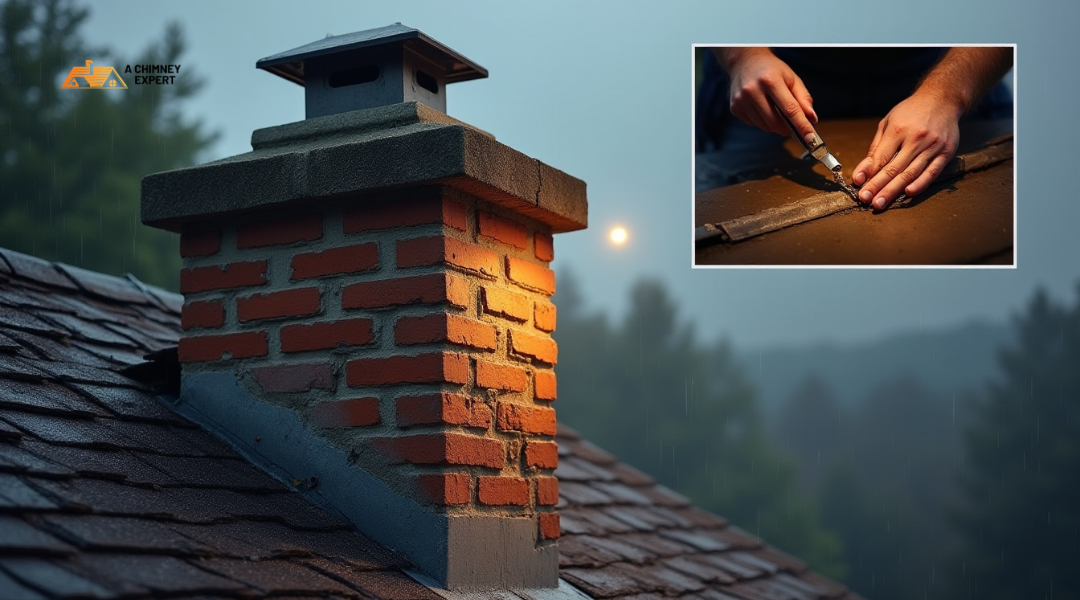
You should inspect these parts for rust, cracks, or gaps. A concrete crown should have a smooth, sloped surface to shed water away from the chimney walls. Stainless steel or copper caps last longer and resist corrosion.
If repairs are needed, use materials rated for outdoor masonry. Proper sealing around the flashing edges helps prevent leaks that lead to freeze–thaw expansion inside the chimney.
Ensure Proper Drainage Around The Chimney Base
Poor drainage at the base of your chimney allows water to pool and soak into the masonry. Over time, this moisture freezes, expands, and causes the bricks to shift or crack. Keeping the area dry reduces stress on the foundation.
You can improve drainage by:
- Sloping the ground away from the chimney.
- Cleaning gutters and downspouts to direct runoff.
- Installing a splash block or drain channel if needed.
Check that landscaping or mulch does not trap moisture near the base. Proper drainage protects both the chimney structure and the surrounding roof and walls from water-related damage.
Why Homeowners In Oak Grove Trust A Chimney Expert LLC
You need a chimney company that understands Virginia’s seasonal challenges, uses proven methods, and values your safety. A Chimney Expert LLC combines decades of experience, certified training, and local commitment to deliver dependable chimney care that protects your home in every season.
45+ Years Of Proven Experience With Virginia’s Weather Conditions
For more than 45 years, A Chimney Expert LLC has served homes across Virginia, including Oak Grove. You benefit from a team that understands how the region’s freeze-thaw cycles, humidity, and rainfall affect masonry and chimney systems.
The company’s technicians know when to apply waterproofing, repair mortar, or inspect for cracks caused by temperature shifts. Their experience helps prevent small issues from turning into costly structural damage.
Common local concerns they address include:
- Brick spalling from repeated freezing and thawing
- Water intrusion through chimney crowns and flashing
- Efflorescence and mortar erosion due to moisture exposure
This long history with local weather patterns ensures your chimney receives care suited to Virginia’s unique climate.
CSIA-Certified Experts In Chimney Waterproofing And Masonry Repair
You can trust that your chimney is handled by CSIA-certified professionals trained in waterproofing, masonry repair, and inspection. Certification from the Chimney Safety Institute of America means technicians follow national safety and performance standards.
A Chimney Expert LLC uses vapor-permeable sealants that prevent water entry while allowing trapped moisture to escape. This approach protects your chimney’s structure during the freeze-thaw cycle.
Their certified team also inspects:
- Brick and mortar joints for cracks
- Chimney crowns and caps for damage
- Flue liners for signs of moisture or corrosion
With skilled, certified care, you reduce the risk of leaks, mold, and long-term deterioration.
Local, Family-Owned Business With Integrity And Transparency
As a family-owned company based in Oak Grove, A Chimney Expert LLC values honesty and clear communication. You receive detailed inspection reports, upfront pricing, and practical recommendations without unnecessary upselling.
Their local roots mean they understand the needs of homeowners in the community. They take pride in maintaining long-term relationships built on trust and consistent service quality.
When you schedule maintenance or repair, the same reliable team arrives—no subcontractors or hidden fees. This personal approach helps you feel confident in every step of the process.
Quick, Reliable, And Safety-Focused Service All Year Round
You can count on prompt, dependable service whether it’s a routine cleaning or an emergency repair after a storm. The company’s scheduling system prioritizes safety, ensuring your chimney stays in working order before winter freezes or heavy rain.
Safety checks include:
- Verifying proper airflow and draft
- Inspecting for blockages or creosote buildup
- Confirming waterproofing integrity after severe weather
Their technicians arrive prepared with the right tools and materials, completing most jobs in a single visit. This efficiency helps protect your home and keeps your fireplace safe for use throughout the year.

